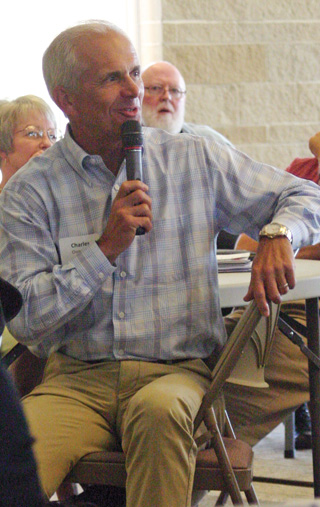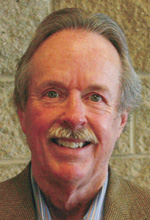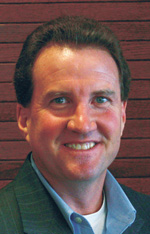By Celine Klosterman

IOWA CITY — To foster stewardship, the Catholic Church must first engage parishioners.
About 55 people heard that message Oct. 11 at St. Patrick Church during the Diocese of Davenport’s Stewardship Day, “Building an Engaged Church.” Wayne Miller and Ray Coogan of Connecticut-based The Cunneen Company, which works to enhance Catholic giving, and attendees shared ideas for increasing parishioners’ connections and contributions to the Church.
“This is a historic moment for us to shift to an emphasis on stewardship of treasure,” Dan Ebener, diocesan director of stewardship and parish planning, said in opening remarks. For the previous 10 years, the Diocesan Stewardship Commission had stressed stewardship of time and talent.
Thirty-five of the 80 parishes in the diocese took part in an offertory enhancement program guided by Cunneen this year, said Sister Laura Goedken, diocesan director of development. Thirty more parishes will participate next year.
The diocese proposed the program in 2012 after noticing the rate of annual increases in household giving had dropped over the previous five years.

“The cornerstone of stewardship is engagement,” said Miller, a regional director for Cunneen. Engagement is different from involvement. The former refers to how Catholics feel about their parish, while the latter is what people do at their church.
In the Midwest, Catholics spread evenly into three groups: engaged, not engaged and actively disengaged, he said. Engaged parishioners attend Mass regularly, invite others to parish activities, and give generously of time, talent and treasure. Not engaged Catholics attend Mass sporadically and offer small contributions. The actively disengaged attend Mass a couple times a year and share little or nothing.
Effective communication plays a key role in engaging Catholics, Miller said. He suggested enlivening parish bulletins with color and varying designs; updating parish websites frequently; and prominently posting Mass times, contact information and forms, along with podcasts of Sunday homilies and a blog by parish staffers. Take advantage of convenient, inexpensive email and social media to share parish news and videos. Try texting, too — a form of communication that reaches youths especially well, a parishioner observed. But direct mail, though costly, is sometimes the most effective method.
Engage donors by keeping them informed and letting them have roles in parish finance, budgeting and future spending, Miller said. Be unapologetically bold in asking for donations — even regular givers need prompting. People give most when they understand how their contributions impact people’s lives.
A priest at the workshop acknowledged the perception that the Church is “always asking for money.” Parish leaders encourage donating funds not only for everyday parish operations, but for the Annual Diocesan Appeal (ADA), more than a dozen annual collections for various organizations and for church building projects.
Miller suggested doing parish appeals two seasons apart from the ADA and emphasizing the different purposes of each request for money.
Seek donations of treasure separately from time and talent, he advised. If parishes appeal for all three types of contributions at once, parishioners may think they can choose just one.

Coogan, also a regional director for Cunneen, later said that the percentage of charitable donations in the United States that goes to religious organizations declined from 45 percent in 1990 to 31 percent in 2010. “If we keep doing the same things, that trend will continue.”
He shared seven steps for promoting gifts of time, talent and treasure: personal witness; commitment of leadership; hospitality, evangelization and outreach; communication and education; recruiting, training and recognizing gifts; stewardship of treasure and accountability.
Living a Christ-like life — inside and outside church — is the best way to evangelize, one attendee said. Other workshop participants suggested reaching out by having parishioners visit new church members at home, offering pictorial directories and small gifts to new members, holding “mix-it-up Sundays” during which Massgoers sit in different pews than usual and meet new people, and organizing ministry fairs.
Offer personal witness throughout the year, Coogan advised. “Stewardship isn’t something you can turn on or off. You must always be talking about it.” Mid-year and budget reports, newsletters and surveys help foster stewardship as a way of life, he said. Also, promote the concept of pledging. Encourage parishioners to fulfill their pledges — perhaps through electronic giving — even if they can’t attend a particular weekend Mass.
Nancy Miller of St. Mary Parish in Eldora, Iowa, said the Stewardship Day was excellent. “I’m here because God brought me here. I got many ideas to take back with me.”
Kathy Brack, pastoral associate at St. Mary Parish in Oxford, appreciated learning both from Cunneen Company professionals and parish representatives. “I was able to garner lots of materials to use as references in preparing a time and talent survey for our use,” she said.
“One of the scary statistics that we talked about a bit is the number of youth who are not returning to the Church after confirmation or college. Someone said if you have them at 21, you’ll have them at 101. That really hit home with me in our need to focus and connect with this particular target group.”








